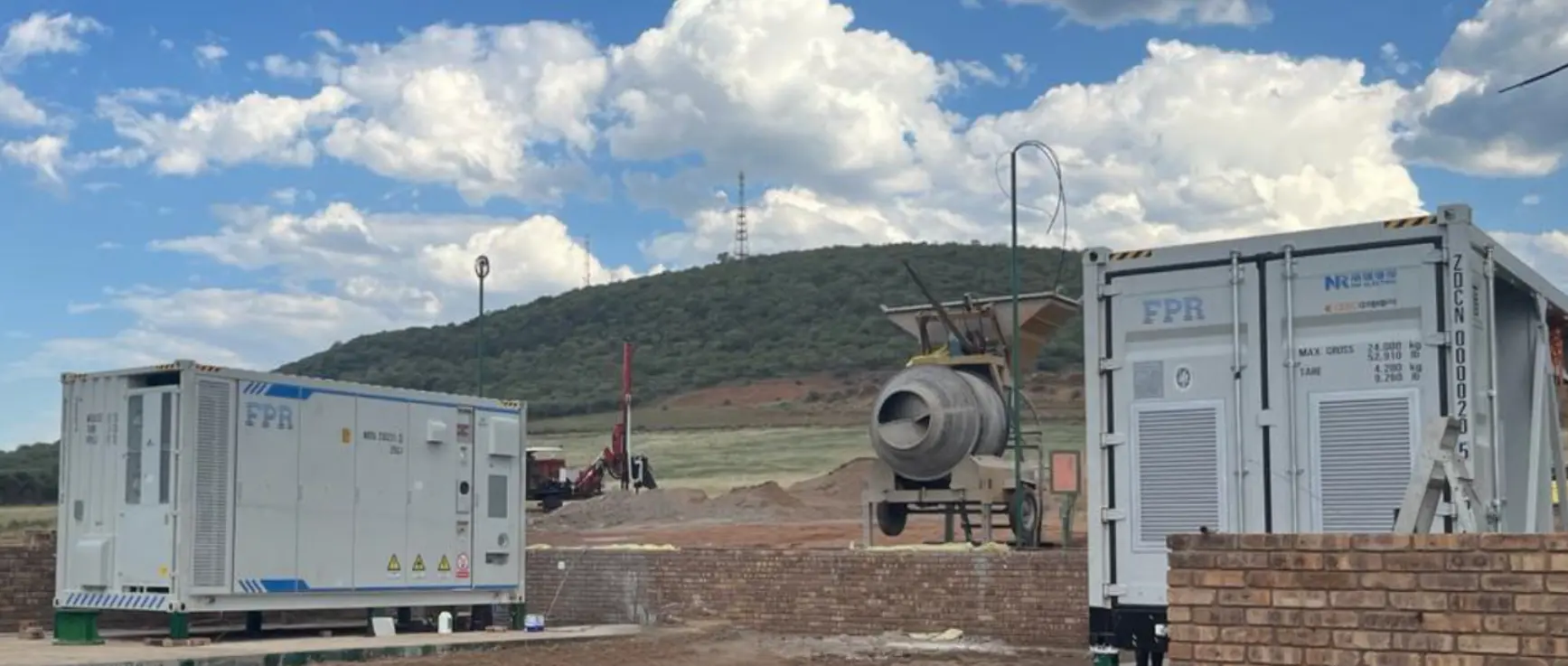

Safe
Our stationary battery energy storage systems feature multi-level stationary storage battery protection, enhanced by advanced liquid cooling technology.

Simple & Fast
Container BESS with factory pre-assembly lowers installation and commissioning costs for commercial stationary battery energy storage systems, ensuring convenient operation and flexible maintenance.

Scalable & Customized
The modular design of stationary battery energy storage systems allows for parallel connections and easy capacity expansion, enabling customized solutions.

Smart
Digital technology enables remote collaboration and intelligent monitoring for stationary battery energy storage systems, enhancing performance through active cell balancing.

Our meticulous multi-staged manufacturing process guarantees the swift delivery of superior quality stationary battery energy storage systems. Each phase, from rigorous material testing to thorough functional assessments, is executed with an unwavering commitment to excellence. Our streamlined logistics operations are designed to ensure that your stationary battery energy storage systems arrive on schedule, ready for installation.

As one of the leading battery energy storage system suppliers, we've integrated cutting-edge digital management systems with our stationary battery energy storage solutions to offer comprehensive lifecycle services for all our products.
OA System: Facilitating seamless communication and collaboration.
PLM System: Enabling comprehensive management of product data and processes.
ERP System: Effectively managing resources to optimize operations.
MES System: Providing real-time monitoring and control of manufacturing processes.

Our dedicated departments ensure excellence in various operational aspects.
Product Technology Department: Pioneering cutting-edge technologies.
Product Engineering Department: Designing, developing, and optimizing products.
Quality Department: Maintaining the highest standards of quality assurance.
Information Center: Serving as a central hub for data management and IT support.

As a leading stationary battery energy storage systems company, we drive innovation and continuous improvement with a dedicated R&D team of 300+ experts. Our state-of-the-art facilities, including a Surge & Lightning Simulator Laboratory and an Aging Laboratory, enable rigorous testing to ensure the safety, reliability, and longevity of our energy storage solutions.
Renewables Integration with BESS:
Technical Aspects: Stationary battery energy storage systems can be sized to match the specific variability of the renewable energy source it's paired with. For solar power, stationary battery energy storage systems might be sized to store a few hours of energy to cover peak evening demand after sunset. For wind power, which can be more variable, stationary battery energy storage systems might need a larger capacity to handle longer periods of low wind.
Smart Charging and Discharging Strategies: Sophisticated software can optimize the BESS's charging and discharging cycles. This can involve factors like weather forecasts, real-time grid conditions, and electricity market prices. The goal is to maximize the use of renewable energy while minimizing reliance on the grid and reducing overall costs.
BESS for Enhanced Grid Stability:
Frequency Regulation: Stationary battery energy storage systems can respond very quickly to changes in grid frequency. By injecting or absorbing energy in milliseconds, stationary battery energy storage systems help maintain the precise frequency required for the grid to function properly. This is crucial for protecting sensitive equipment from damage.
Voltage Control: Similar to frequency regulation, stationary battery energy storage systems can also help regulate voltage on the grid. By injecting or absorbing reactive power, stationary battery energy storage systems can prevent voltage sags (voltage drops) or swell (voltage spikes) that can disrupt electrical equipment.
Peak Shaving with BESS in Action:
Real-World Example: Imagine a commercial building with a large air conditioning system. During the hot summer afternoon, when everyone is using AC, electricity demand soars, pushing up prices. The building can install a BESS container to store excess cheaper energy during off-peak night hours. Then, during the peak afternoon hours, the utility BESS can discharge the stored energy to power the AC, reducing reliance on the expensive grid and lowering overall electricity costs.
BESS for Backup Power — Going Beyond Hospitals:
Beyond Critical Facilities: While hospitals and data centers are prime examples, BESS backup power can be beneficial for other applications. For example, telecommunication towers can use stationary storage systems to maintain uninterrupted service during outages, ensuring cell phone connectivity remains available.
Microgrids with BESS — A Technical Breakdown:
System Components: A microgrid with BESS container typically includes renewable energy sources (solar panels, wind turbines), local backup generators (often powered by natural gas), and a smart control system. Stationary battery energy storage systems act as the energy storage hub, while the control system manages the energy flow between all the components to meet the microgrid's electricity needs.
Islanding Capability: Microgrids with stationary battery systems can be designed to "island" from the main grid, meaning they can disconnect and operate autonomously during outages. This provides exceptional resilience and energy security for critical infrastructure in remote locations.
Optimizing EV Charging with BESS:
Vehicle-to-Grid (V2G) Integration: An exciting future application involves using electric vehicle batteries as a distributed energy resource. With V2G technology, EVs plugged into a charging station with stationary battery energy storage systems can not only receive a charge but also discharge excess stored energy back into the grid during peak hours. This creates a two-way flow of energy, further enhancing grid stability and efficiency.
In the relentless pursuit of sustainable and eco-friendly energy solutions, the development of stationary battery energy storage systems has emerged as a crucial linchpin in the integration of renewable resources into our power grids. Renewable energy sources, such as solar and wind, are inherently intermittent, producing electricity when the sun is shining or the wind is blowing. This intermittent nature poses a significant challenge to maintaining a stable and reliable power supply, especially when demand does not align with the sporadic nature of these resources.
Enter the electrical energy storage systems — the technological marvel designed to bridge the gap between energy production and consumption, fostering a harmonious relationship between renewable sources and the grid. These stationary battery energy storage systems store excess energy generated during periods of high renewable output and release it when demand surpasses immediate supply. The result is a more resilient and flexible energy infrastructure capable of adapting to the variable nature of renewables.
One of the most promising technologies in the realm of energy storage is battery storage. Lithium-ion batteries, in particular, have undergone remarkable advancements, becoming the cornerstone of many grid scale energy storage systems and projects. These energy storage devices offer high energy density, rapid response times, and an extended cycle life, making them ideal candidates for efficiently storing and releasing renewable energy.
The benefits of implementing energy storage systems for renewable energy are multifaceted. First and foremost, these community energy storage systems contribute to grid stability by mitigating the intermittency of renewable sources, thus ensuring a consistent power supply. Furthermore, these electrical stationary battery energy storage systems empower communities to harness and utilize locally generated renewable energy, fostering energy independence and reducing reliance on centralized power plants.
As technology continues to evolve, the future of stationary battery energy storage systems holds even greater promise. Innovations in materials science, artificial intelligence, and grid electricity storage management are poised to enhance the efficiency and affordability of these grid scale energy storage systems, making them increasingly integral to the global transition toward a more sustainable energy landscape. In the grand tapestry of renewable energy integration, grid energy storage systems emerge as the threads that weave resilience, reliability, and sustainability into the fabric of our power grids.

Battery Technology: The lithium-ion batteries that power our stationary battery energy storage systems are renowned for their efficiency, extended cycle life, and high energy density. This decision guarantees peak efficiency, dependability, and a more environmentally friendly energy storage option.
Charging (Energy Intake): Our stationary battery energy storage systems charge the lithium-ion batteries when there is a surplus of electricity generated or when demand is low. This usually happens when surplus electricity is produced by renewable energy sources like solar or wind.
PCS: The Power Conversion System, often known as the PCS, is essential to the functioning of our stationary battery energy storage systems. It is in charge of changing the lithium-ion batteries' direct current (DC) electricity into alternating current (AC). Compatibility with multiple devices and the electrical grid requires this change.
Energy Storage: We can capture and store energy for later use because the converted AC electricity is kept in lithium-ion batteries. Our battery bank's capacity is tailored to match the demands of our particular application.
Discharging (Energy Release): Our stationary battery energy storage systems release stored energy when power demand exceeds supply or during periods of peak demand. The PCS makes it easier to transform stored energy from DC to AC so that it can be distributed into the power grid.
Grid Integration and Services: To deliver important services, our stationary battery energy storage systems are thoughtfully included in the electrical grid. These services include:
• Frequency regulation: For increased stability, quickly adapt to variations in grid frequency.
• Peak Shaving: Reducing reliance on peaker plants and easing grid strain by discharging during periods of heavy demand.
Control Systems: Our BESS's charging, discharging, and general operation are all managed by sophisticated control systems. These stationary battery energy storage systems respond dynamically to grid signals or user-specified preferences while maximizing performance and guaranteeing safety.
Monitoring and Maintenance: An essential component of our strategy is ongoing monitoring, which guarantees the functionality and health of our lithium-ion batteries. Temperature control, capacity testing, and the recurring replacement of old batteries are examples of routine maintenance tasks.